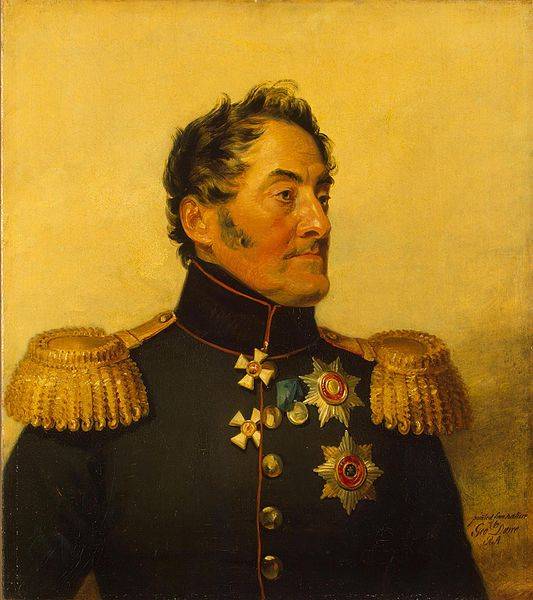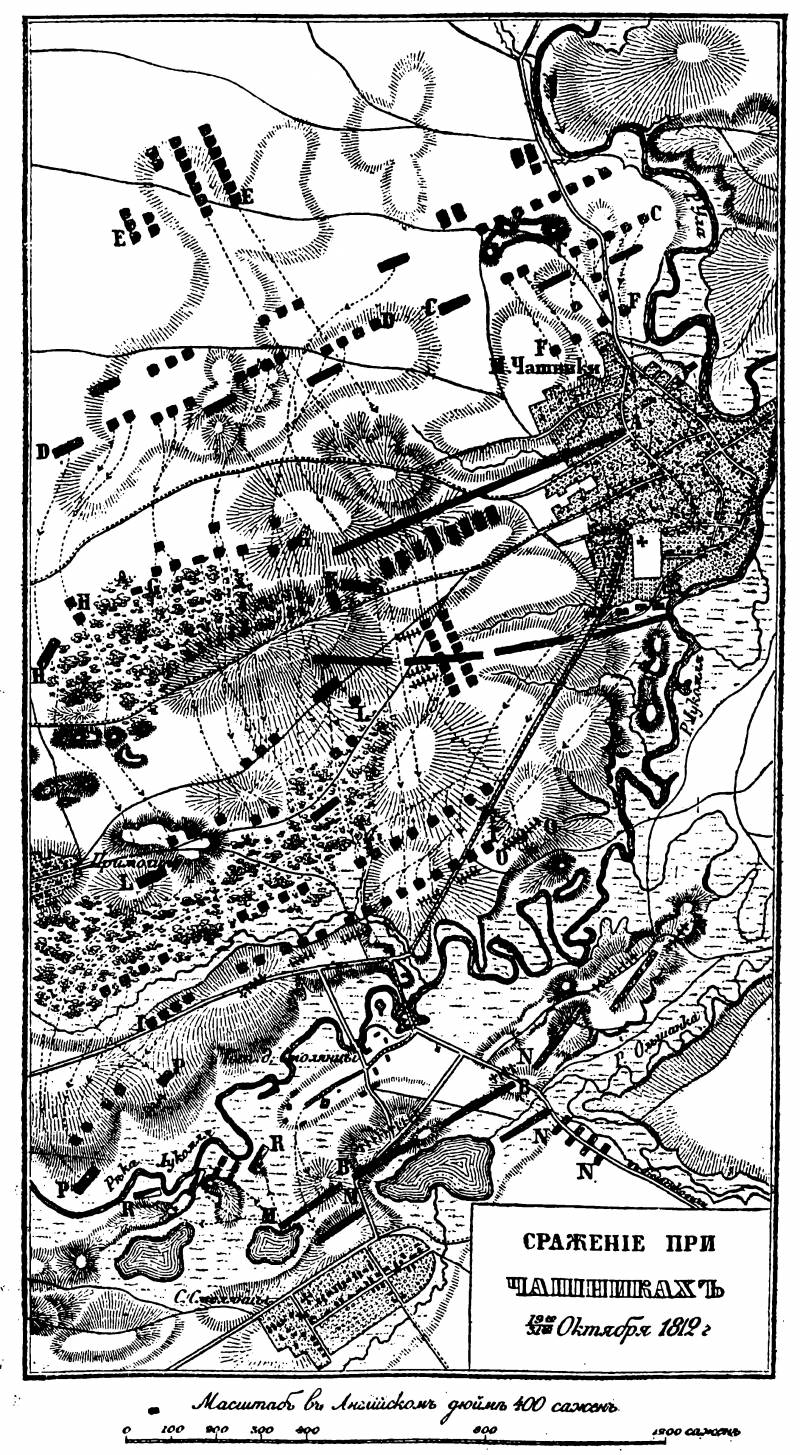The defeat of Marshal Viktor in the battle of Chashniki

Victor Mazurovsky. Bivouac of Napoleon's retreating army
General situation
After the battle near Polotsk (The defeat of the French army in the second battle of Polotsk), the 2nd Corps under the command of General Legrand (Saint-Cyr was wounded) retreated south to Chashniki. As a result, the 30-strong Russian army under the command of Wittgenstein on the northern wing dangerously approached the rear communications of the French army. At this time, Napoleon's army left Moscow and began to retreat.
In order to avoid a flank attack from the north, part of the reserve 2th Corps of Victor, which entered Russia in September and was stationed in Smolensk, was sent to help the 9nd Corps. On October 17–19 (29–31), 1812, the 2nd and 9th Corps joined on the Ule River. The number of the French grouping grew to 36 thousand soldiers. Victor received an order from Napoleon to return Polotsk and push the enemy back across the Western Dvina.
The French were ready to give battle. The soldiers of the 2nd Corps were pleased with the strong reinforcements and perked up. And the troops of Marshal Victor had not yet participated in the battles and wanted to distinguish themselves. The regiments of the 9th Corps, which did not participate in exhausting marches and fierce battles, were in good condition.
Battle preparation
On October 18 (30), 1812, Merle's division from the 2nd Corps took up a position at Chashnik. Prince Yashvil (a Russian general of Georgian origin), with the vanguard of the Russian army, was located near the enemy. It was clear that the enemy was ready for active hostilities. The Russian commander Wittgenstein, not knowing about the appearance of fresh troops of Victor, decided to launch an attack on October 19 (31). His troops were located behind the vanguard of Yashvil, 3 versts near the village of Sloboda.
Claude-Victor Perrin, having under the command of the main forces of the two corps, was ready for battle. He ordered the troops, who had not yet arrived at Chashniki, to speed up the movement. Such an order was received by the French divisional general and Marshal of the Netherlands Herman Dandels, who led two divisions from the Beshenkovichis, and the corps cavalry. Dandels led soldiers to the Lukoml River on the night of October 18-19, but only one division. The cavalry set out on the morning of 19 October. The marshal, deprived of the support of one division and 2 thousand cavalry, postponed the offensive until the concentration of all forces.
French troops were stationed on both sides of the Lukomli River. The divisions of Merle and Maison from the 2nd Corps stood in the first line, ahead of Chashnikov, on the right flank to the river. Ole, with the left they rested against the forest (it was occupied by the French infantry). The troops of the 9th Corps were located on the heights of the right bank of the river. The message between the French troops was the dam near the manor Smolyantsy, 2 versts from Chashnikov. At the forefront, Victor had up to 10 thousand people.

Portrait of Lev Mikhailovich Yashvil (1772–1836) by George Dawe. Military gallery of the Winter Palace
The battle
At dawn on October 19 (31), General Yashvil led his detachment into battle - 13 battalions, 3 militia squads, 15 squadrons and 2 Cossack regiments with 28 guns. The Cossacks shot down the advanced posts, then at 7 o'clock in the morning Prince Yashvil with the 5th Jaeger battalions crossed the river and attacked the enemy, who occupied the place. But the French were numerous and fought bravely. Our troops have withdrawn.
Soon the main forces of Wittgenstein's army approached. Steingel's Finnish corps formed up to the right of the vanguard, while Berg's corps remained in reserve. Yashvil again attacked in Chashniki and pushed the enemy back from there. At the same time, the Grodno hussars on the right flank overturned the enemy cavalry. Steingel tried to advance in the forest, but he was repulsed. The general repeated the attack with already large forces, sent rangers and cavalry around the enemy. The French cleared the forests and, pursued by dragoons and hussars, retreated across the river. Lukoml. The troops of the right French flank also retreated across the river. After the retreat of the forces of the 2 Corps across the river, they settled on the left flank of Victor's troops.
Meanwhile, Wittgenstein learned from the prisoners that Marshal Victor had arrived to help the 2nd Corps, and refused to continue the offensive. The troops of Yashvil and Shteingel settled down against the French troops, Berg's corps and cavalry remained in reserve. Further hostilities were limited to artillery skirmishes. Russian gunners suppressed several enemy positions. By evening, another division joined Victor's troops.
The next day, Victor withdrew the troops. This aroused the displeasure of Saint-Cyr, who, due to being wounded, did not participate in the battle. He believed that the 9th corps should have come to the aid of the regiments of the 2nd corps, which was in the first line, and the French would go on the general offensive.
In the battle of Chashniki, our troops lost about 400 people. The enemy lost about 120 people, including more than 800 prisoners. This victory had an adverse moral effect on the French army and worsened the operational situation. Victor could not solve the task and throw the Russians behind the line of the Western Dvina and thereby ensure the safe retreat of Napoleon's troops. Wittgenstein's troops got even closer to the enemy's main communications. There was an opportunity for joint action with Chichagov and Kutuzov.

Battle of Chashniki 19 (31) October 1812 Map source: P. A. Niva. Patriotic War. Volume IV
Liberation of Vitebsk
After the battle of Chashniki, General Wittgenstein transferred his troops to the right side of the Ula and stationed them at Chashnikov. He gave the troops a rest and waited for news from Chichagov's army. The cavalry conducted reconnaissance. Wittgenstein, after Victor's retreat, was able to send detachments to Borisov, Minsk and Vitebsk. The main forces stood still until 1 (13) November. The detachment of Major General Vasily Garpe (2 battalions, 2 squadrons with 2 guns) was sent to Beshenkovichi. The consolidated hussar regiment was sent to Lepel to observe the remnants of the 6th Bavarian corps in Glubokoe. Alekseev's avant-garde is located on the roads to Senno and Vitebsk.
An important task was the liberation of Vitebsk, where large military stores of the French army were located. The Harpe detachment was reinforced with 2 battalions, 2 squadrons, a hundred Cossacks and 4 guns. On October 25 (November 6), 1812, Russian troops entered Staroe Selo and the next day moved along the right side of the Dvina to Vitebsk. Lieutenant Colonel Stolypin walked along the left bank of the river with 2 squadrons of the Yamburg Lancers. Both detachments approached Vitebsk at dawn on October 26 (November 7).
The enemy was taken by surprise, but acted quickly. The guard at the Polotsk outpost moved to the left side of the Dvina and set fire to the bridge. The advanced forces of the Russian detachment started a firefight with the enemy. Soon Harpe arrived with the main forces. A platoon of the horse artillery company of Lieutenant Sukhozanet of the 2nd cleared the buildings nearby from the bridge with grapeshot. Volunteers from the 26th Jaeger Regiment and the 7th squad of the Petersburg militia ran across the burning bridge to the left side. Some began to pursue the enemy, others to put out the fire.
As a result, our troops ousted the French from the city. At the exit from Vitebsk, the enemy was attacked by Stolypin's detachment. Many French were taken prisoner. He also scattered several hundred Frenchmen who were stationed in the area of the city. The Harpe detachment lost 44 people in this battle. About 400 French were captured, including the Vitebsk governor, Brigadier General Pouget, and ten staff and chief officers. Large stocks of provisions were seized in the city. The French army lost one of its main food bases.
Information